| |
A Timeline
|
|
|
There are few connections between the Bronte family & photography but
it was all around them in the 1840s.
This is a chronology of some of the main events in Bronte history
alongside important events in photographic history; it also lists the opening of the
early Yorkshire photographic studios.
|
|
1820s &
1830s
|
|
Watch a six-minute video explaining the
evolution of photography - by George Eastman
Museum.
(Silhouette
portraits, the pantograph,
the camera obscura, Thomas Wedgwood etc).
|
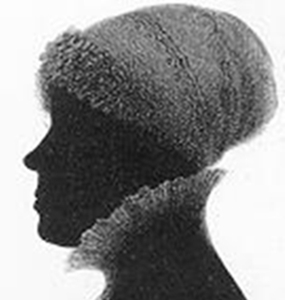
Elizabeth
Branwell
In 1821, after the death of Rev Patrick Bronte's
wife Maria, her sister (Aunt) Elizabeth Branwell,
moved from Penzance to Haworth to help raise his son and five daughters.
Two daughters, Maria and Elizabeth died in 1825, leaving Branwell, Charlotte, Emily
and Anne.
|
|
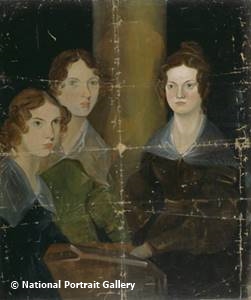
Branwell studied art under John
Bradley and then William Robinson where he met John Hunter Thompson. Branwell
was only about 17 years-old when he painted this portrait of his
sisters c1834.
|
Before photography, the cheapest way to obtain a true likeness was to have a
profilist create a silhouette, cut either by hand or machine. In the advert below from 1836 a small
basic silhouette likeness in a glazed frame cost one shilling.
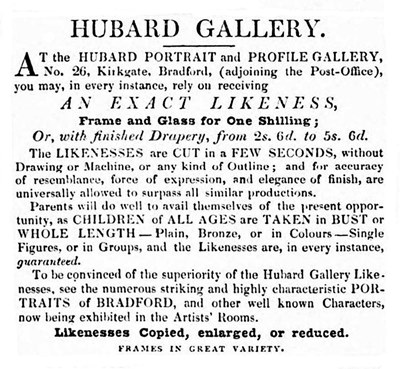 |
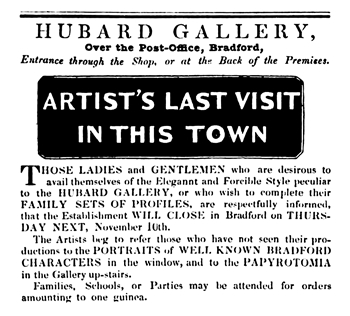 |
|
The Hubard Gallery travelled the country taking up residence in
towns for several weeks before moving on. The
artists were in Bradford,
Yorkshire, in October-November 1836.
Profile artists produced silhouettes of anyone or anything, including animals
and buildings. Two of the artists, advertised as "Bracy and Elford [of
The Hubard Gallery]", visited Bradford again in 1839 and
"E.Lancaster, late of the Hubard Gallery" in 1844.
|
|
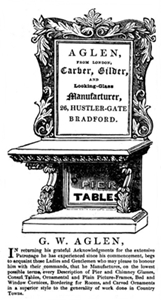
|
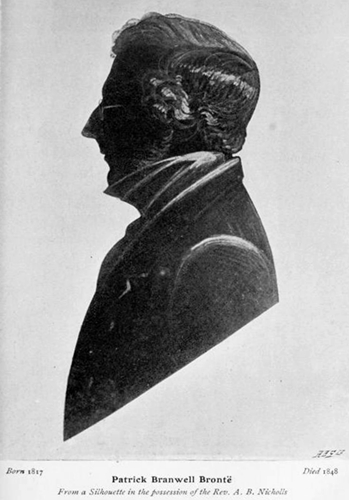
|
|
In 1838 Branwell
Bronte (1817-48) moved to Bradford to begin his career as a portrait
painter in oils but these portraits would have been unaffordable to all
but a few people in what was then a large industrial town, not yet a
city. He worked with his friend, John Hunter Thompson (1808-90), who was
working from a studio in the premises of George William Aglen, a carver and
gilder on Hustlergate.
A handful of landscape and
portrait artists existed in Bradford but this was not their
main occupation. John Hunter Thompson
(1808-90) became a well-known portrait painter in Yorkshire, but in
the 1830s was also a house painter, and in the 1840s a beerseller as
well.1. The artist John Wilson
Anderson (1798-1851), also on Hustlergate, was a house & sign painter, carver &
gilder. Portrait painting alone could not
support Branwell in Bradford and he returned to Haworth in
1839.
|
|
|
1839
|
|
Photography was at an experimental stage in the late
1830s and there were two main types of photos; calotypes and
daguerreotypes.
The Daguerreotype
A camera was used to produce a sharp, detailed image on a silvered copper plate.
One downside was that, due to the mirror-like surface, the image could only be viewed from certain
angles.
Watch a six-minute video explaining
daguerreotypes - by George Eastman
Museum.
Unlike calotypes, there was no negative so copies could only be made by
photographing the daguerreotype. Almost all daguerreotypes are reversed images so any text, a shop
sign for example, would appear back to front. If a copy was made the image was reversed again,
correcting the orientation, as seen below.
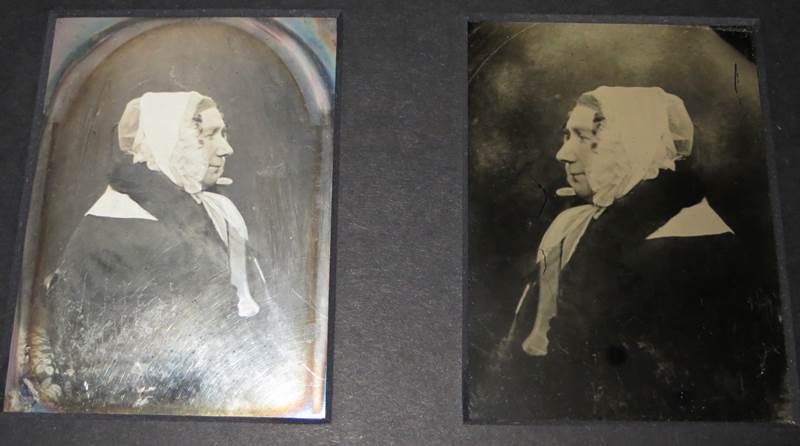
Above: Example of an
1840s daguerreotype (left) and an 1850s collodion copy (right).
The marks around the edges of this daguerreotype were caused by the silver surface
reacting to the metal frame; the photographer has tried to avoid this when copying the
photo.
The Calotype
Watch a six-minute video explaining calotypes
- by George Eastman
Museum.
A camera was used to produce a paper negative and from this many positive prints
could be made.
This produced a soft image but it lacked detail, partly due to the grain of the paper.
Above: Examples of calotype photos on paper taken by Hill
& Adamson between 1843 & 1848; they visited York in 1844.
By 1840 it
was clear, from a commercial point of view, that the daguerreotype was the winner.
Gradually, throughout the 1840s, daguerreotype portrait studios opened in cities, large towns and
resorts across Europe.
|
|
1840
|
|
The Bronte family were well read, and had a keen interest in art,
but reports and articles about the new art of photography would have meant little to them. In
common with most people in 1840, they had never seen a photograph.
|
Branwell Bronte's brief career as a portrait painter in
Bradford lasted less than a year. In 1840, after a period as a tutor in
Broughton in Furness, he began work as a clerk for the Leeds &
Manchester Railway Company.
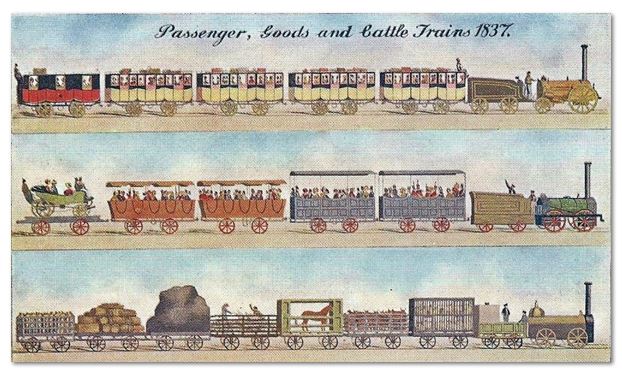
|
By
this time the three sisters had finished their education and were seeking positions, either as
assistant teachers in private schools or as governesses within
a family. At least two classified adverts were published in the
Yorkshire press and Anne Bronte was employed as governess for the Robinson family at
Thorp Green Hall, Little Ouseburn, near York, from May 1840 until June
1845.
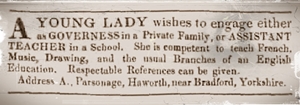
|
|
1841
|
|
Those who in portraiture are fond of being "flattered," will certainly not
patronise the Photographic method of taking likenesses: but on the other hand, they who want the
real thing, and we presume them to be the majority, will unquestionably spend a guinea in the
production of a miniature portrait, which their fathers and mothers, wives, sisters and brothers
"may swear to." 1a
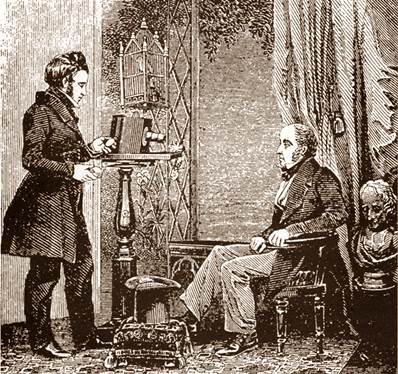
The
first photographic manuals were published in England in 1839, one of them by Smith,
Elder, & Co. The process was technical and far too expensive
for all but a few members of the public. The first photographic studio in England opened
in London in March 1841 but the Brontes were
hundreds of miles away in Yorkshire.
Charlotte was governess for the White family at
Underwood House, Rawdon, near Leeds between April and December 1841. Living under someone
else's roof was not easy for the sisters and
they
planned to open a school of their own at Haworth
Parsonage.
This would require further education and Aunt Elizabeth Branwell helped finance Charlotte and
Emily's study at a school in Belgium. Anne remained at Thorp Green
Hall.
|
|
1842
|
|
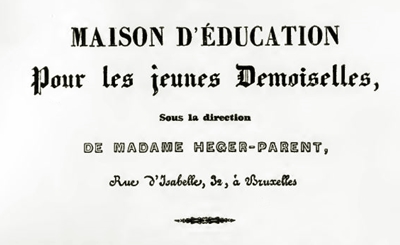
Charlotte and Emily travelled to Belgium, arriving in Brussels in February
1842. They spent the following nine months learning French and German at a
boarding school, the Pensionnat Heger, in rue d’Isabelle. Charlotte was 25 and Emily 23 years
old.
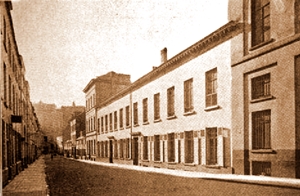
Pensionnat Heger and Rue d'Isabelle, Brussels.
In March 1842, just a few weeks after their arrival, the first
photographic studios in Brussels opened; these were probably the first in Belgium. One was in the
Bazar Pantechnique, the old Royal Stables in rue Ducale; this was south-east of the park and about
500 yards (450 metres) from the Pensionnat Heger.1a.
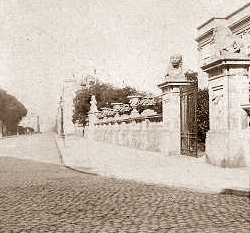
Rue Ducale, Brussels.
A second studio opened in competition, operated by the Brand Brothers
(Baptiste, Antoine & Julien). They were established opticians with a shop in rue du
Marché Aux Herbes (Grasmarkt). This was north-west of the Park, about half a mile from the
Pensionnat Heger. The Brand Brothers (les Frères Brand) were opticians to the Queen of Belgium and
in August 1842 made a daguerreotype portrait of Prince Philippe of Belgium
(below). The photo was taken either at the studio or the Royal Palace, within a mile of Charlotte
and Emily Bronte at the Pensionnat Heger.
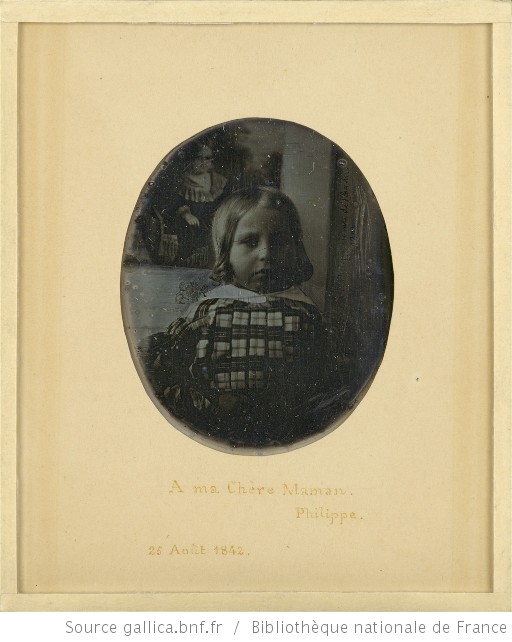
Example of an early daguerreotype - a
photo on silvered copper plate. A portrait of Prince Philippe of Belgium, (1837-1905)
by Frères Brand,
Bruxelles, August,1842. The clarity of this
photo is surprising given that it was taken in the earliest years of commercial photography
and that the subject was a 5-year-old. Exposure times varied depending mostly on
the amount of light but from 1845 they were reduced to a few
seconds. To view an enlargement of this photo visit the gallica website. On the daguerreobase website are other
daguerreotypes by the Brand Brothers of Brussels; a gentleman (1848), a Roman Catholic priest
(undated) and a lady (1853).
There is no evidence that Emily and Charlotte knew about
these photographic studios though there was publicity in the Belgian press (see this external website).
Charlotte and Emily remained in Brussels during the summer
holidays but Aunt Branwell, who had paid for their studies, died and so they returned to
Haworth on 8 November 1842.
|
|
Whilst Emily and Charlotte had been in Belgium a daguerreotype studio had
opened in Leeds (below). Another opened in Scarborough, for the duration of each summer
season from 1842. This holiday resort is where their sister Anne, as governess to the children
of the Robinson family, spent several weeks.

The Photographic Portrait Gallery, Leeds which had a rooftop studio.
1a
|
|
1843
|
|
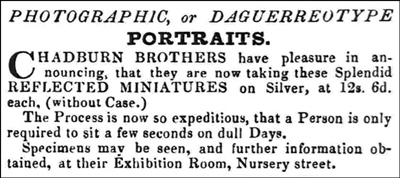
The brothers, Alfred & Wright Chadburn
(opticians), opened a photographic studio in Sheffield, the first adverts appearing
14 January 1843.
The three sisters
inherited about £300 each from their Aunt Branwell, mostly invested in railway shares paying good
dividends. Branwell joined his sister Anne as a tutor to
the Robinson's children at Thorp Green Hall near
York. In
February 1843 Charlotte returned alone to the Pensionnat at
Brussels, as a student teacher. She spent the rest of the year there, becoming increasingly
attached to her tutor, Constantin Heger, he was though married with children.
Emily did not return to Belgium, she remained at Haworth
Parsonage but continued studying the German language. Anne was also learning German and on
14 September 1843 purchased Rabenhorst's Pocket Dictionary of the German and
English Languages, presumably in York.
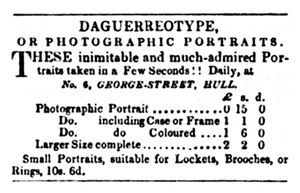
Edward Holmes obtained a license from Beard to take daguerreotypes in Hull and
by October 1843 had opened a studio at no.6, George Street.
|
|
1844
|
|
Charlotte left Belgium in January 1844 and returned to Haworth
but she wrote letters to her tutor Constantin Héger in
Brussels.
|
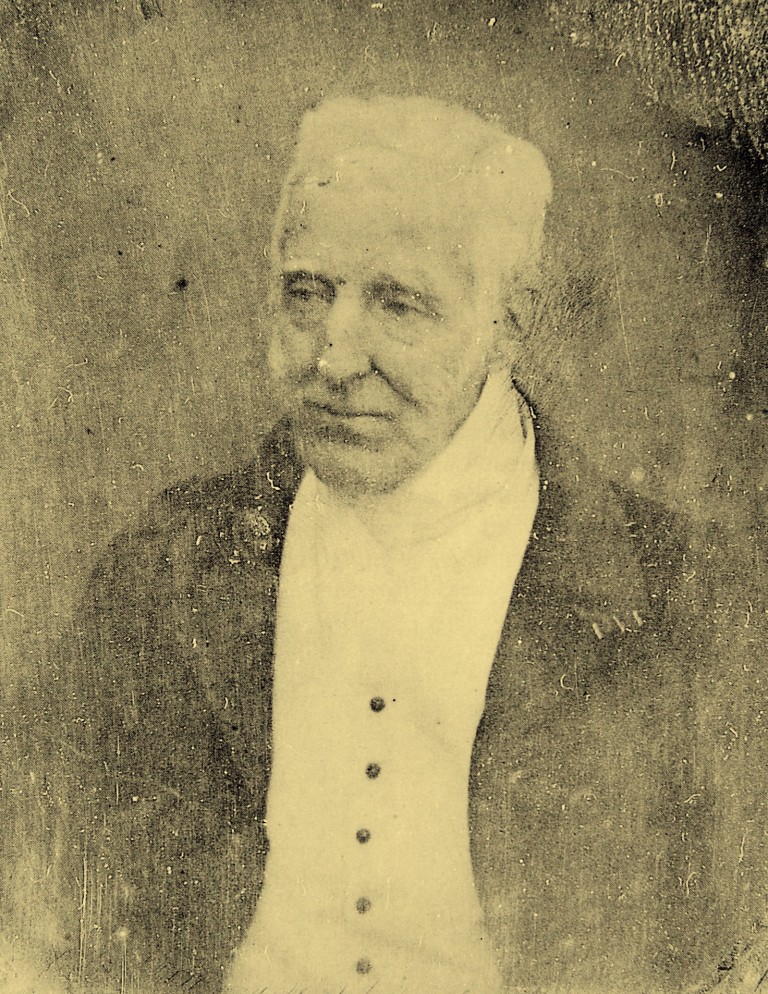
The Duke of Wellington's daguerreotype
(1844) and the engraving (1845) based on one of the
photos.
|
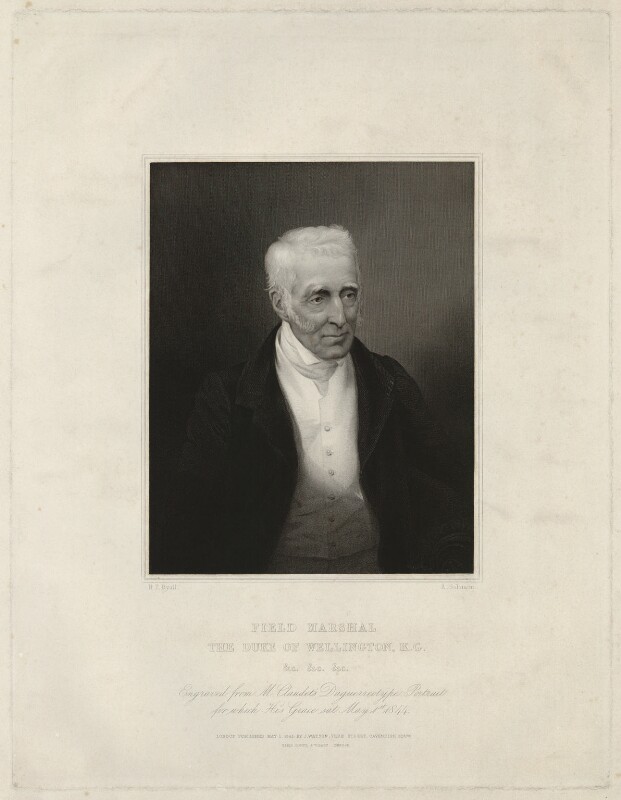 |
Patrick and Charlotte Bronte's hero, the Duke of Wellington (1769-1852), sat
for many artists over the decades; these paintings were copied
as engravings which were sold to the public. Wellington lived well into
the age of photography and on his 75th birthday, 1st May 1844, he sat for two daguerreotype
photographs. These photos were taken at the studio of Antoine Claudet
(1797-1867) when Wellington visited the Adelaide Gallery in London. An engraving
made from one of the photographs was first published in
1845.
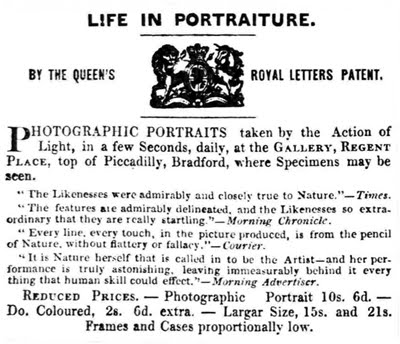
Advert for the Daguerreotype Gallery, Bradford,
1844.
A
daguerreotype studio opened in Regent Place, Bradford in September
1844 offering portraits for as little as 10s. 6d (52½p) which could
be hand-coloured for an additional 2s 6d (12½p). Larger sizes were 15s. (75p) or 21s.
(£1.05p).
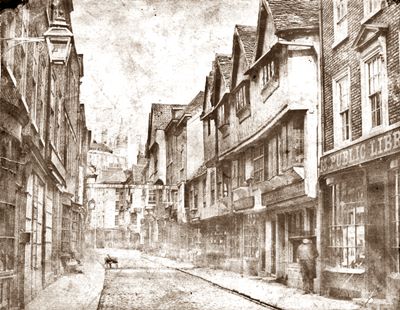
Stonegate, looking towards York Minster
with Bellerby's Library & Bookshop on the right.
Samuel Walker opened the first daguerreotype studio in York, September
1844. This was in Stonegate, almost opposite Bellerby's, a library &
bookshop used by Branwell and Anne Bronte who were at
nearby Thorp Green Hall. Between 26
September & 2 October 1844 the
British Association for the Advancement of Science met in York. David Octavius Hill & Robert Adamson attended and took calotypes
(photos on paper from a paper negative) of many eminent Victorian
scientists.
November 1844 The
sisters plan to open a school at Haworth Parsonage was abandoned and
in December 1844 Anne & Branwell, who were working at Thorp Green
Hall, returned to Haworth for the
holidays. The sisters' friend Mary Taylor returned from
teaching in Germany and stayed at Haworth Parsonage late December 1844 and/or early
January 1845.
|
|
1845
|
|
18 January 1845, the day after Anne Bronte's 25th birthday, she
returned with Branwell to Thorp Green Hall, York. In March 1845 Charlotte's close
friend, Mary Taylor, emigrated to New Zealand aboard the Louisa Campbell and arrived in Wellington,
New Zealand at the end of July.
|
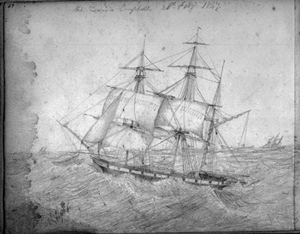
|
|
The Louisa Campbell in
February 1847, on its second voyage to New Zealand, which ended in May when it was
wrecked on a sandbank.
© National Library of New
Zealand.
|
May 1845 Arthur Bell Nicholls, Charlotte's future husband, was appointed as curate
at Haworth, assisting her father, Rev Patrick Bronte. June 1845 After five years,
Anne Bronte's employment as a governess for the Robinson family ended and she returned to
Haworth. At the end of June, Anne travelled with Emily to York. July 1845 Branwell was
dismissed from his post at Thorp Green Hall, presumably after his affair with Mrs Robinson was
discovered by her husband.
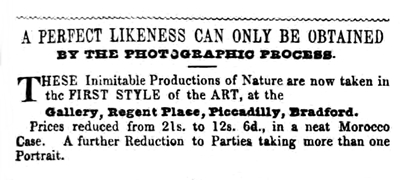
Advert for the Daguerreotype Gallery, Bradford, May, 1845.
The daguerreotype studio in Bradford reduced the prices of their larger
photographs from 21s (£1.05p) to 12s. 6d (62½p) and this included "a neat Morocco
case." The venture had not been a success and it closed
about May 1845. Early portrait photographers in Bradford seem to have suffered the same
problems as portrait artists, a lack of clients.
June-September
1845 The Leeds Polytechnic Exhibition of Arts,
Industry & Science included a photographer installed in a temporary studio taking daguerreotype
portraits at half the usual cost. William Henry Fox Talbot visited York in
July 1845 and took calotype photos of
several buildings including one of York Minster.
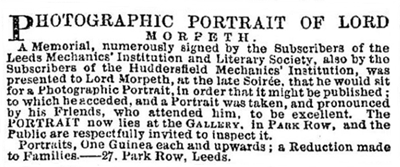
An advert from 1845 for The Gallery, the
Leeds daguerreotype studio. Photographs of well-known people such as Lord Morpeth were taken and
displayed at studios. This showcased the quality of the photographer's art and was intended to
attract the middle classes.
By August 1845 Ann Cooke had
taken over the photographic studio in Hull from her brother Edward Holmes. She had previously
(1844) held the license to take daguerreotype photographs in Lincolnshire and was one of the first
female photographers in the United Kingdom. A studio opened in Halifax the same year.
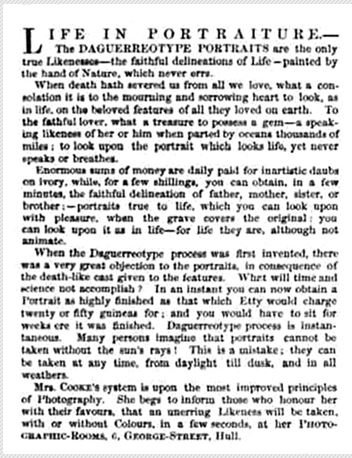
Above: An advert
for Mrs Cooke's studio in Hull,
1845.
Daguerreotypes were used by artists, engravers and even sculptors.
|
A
finely executed bust of the late Mr Robert Spence, of North Shields, has just
been finished by Mr James Shotton, a young and rising artist of that town.
The character and expression of the face resemble the late respected
gentleman very much indeed. The bust has been executed from a small
Daguerreotype portrait of Mr Spence, and, therefore, the credit of a
successful likeness in this case adds an additional lustre to the genius of
the artist. Mr Shotton has promised to place the bust in one of the public
buildings in the town. 2a
The Newcastle Courant, 17 October,
1845
|
|
|
1846
|
|
April 1846 the York Institute of Popular Science &
Literature held a bazaar in their newly-built lecture rooms in St Saviourgate. There was an
exhibition which included many artworks and included some of Samuel Walker's daguerreotypes of
"some of the principal inhabitants of York."
May 1846 Charlotte, Emily & Anne published a book
of poems under the pseudonyms, Currer, Ellis & Acton Bell; but it only sold two
copies.
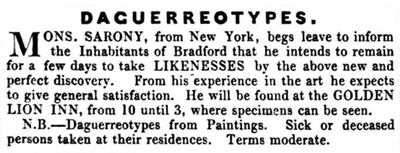
In the summer an itinerant photographer, Olivier Sarony, visited
Yorkshire towns and cities; this advert is from his visit to Bradford in August 1846. He
went on to become one of the most successful photographers in the country with a palatial studio in
Scarborough and branches in other parts of England and Ireland. Sarony was licensed to take
daguerreotypes but there were unlicensed photographers as well.
|
|
1847
|
|
March 1847 the railway from Leeds was extended to
Keighley, not far from Haworth. During the year daguerreotype studios opened in Harrogate,
Wakefield and Whitby.
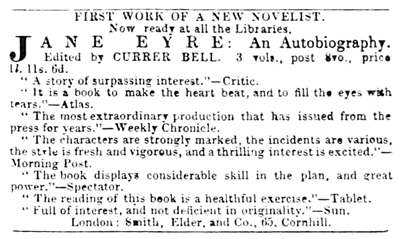
The first of the the Bronte sisters' novels to be published was Charlotte's
Jane Eyre, under the pseudonym Currer Bell, in
October 1847.
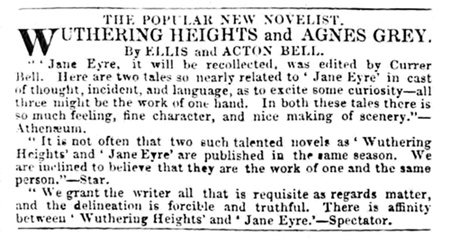
The Morning Post - Wednesday 29 December 1847
In December
1847 Emily's Wuthering Heights and Anne's
Agnes Grey were published together in three volumes. They also
used pseudonyms but their publisher was Thomas Cautley Newby. One of the
first reviews was in The Spectator
on 18 December 1847. Because of the success of Jane Eyre, Newby was fuelling rumours that the works
of 'Acton Bell' and 'Ellis' Bell, were actually by one author, 'Currer
Bell.'
|
|
1848
|
|
Charlotte began using the word "daguerreotype" in her letters with perhaps the
earliest mention on 12 January 1848. This was in a letter concerning Jane
Austen's Pride and Prejudice and was sent to the critic, George Henry Lewes: “An
accurate daguerrotyped portrait of a commonplace face: a carefully fenced, highly cultivated
garden, with neat borders and delicate flowers: but no glance of a bright, vivid physiognomy, no
open country, no fresh air, no blue hill, no bonny beck.”
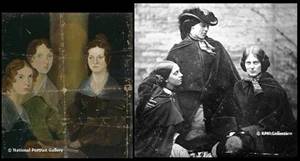
The 'Bronte sisters photo' is taken in a garden. If these are the sisters then
it is a copy of an earlier photo and the original daguerreotype was probably taken between 1845 and
1848. It would have been a reversed image with Charlotte on the right and composition reminiscent
of the 'Pillar' portrait.
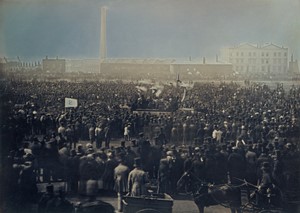
At least two daguerreotype views were taken by William Edward Kilburn on 10 April 1848 of the
Chartist meeting at Kennington Common, London. This demonstrates how, even without good light, a
photo could be taken in a few seconds; it can be viewed HERE. As with most daguerreotypes, this is a reversed image
(see the banner under the hustings).
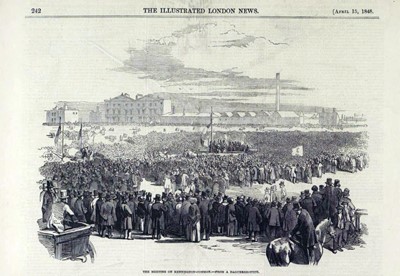
Another daguerreotype view of the meeting, taken from a similar angle, was
engraved and published (orientation corrected) in the Illustrated London News, 15 April 1848.
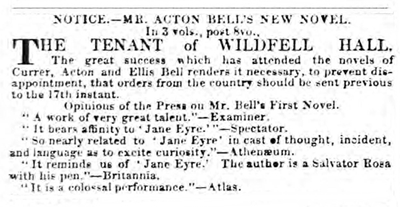
The Morning Post - Tuesday 06 June 1848
Anne's Tenant of Wildfell Hall was published at the end
of June 1848, again under the pseudonym of Acton Bell.
8-11 July 1848 Charlotte & Anne visited London to resolve the
question over authorship of the 'Bell brother's' novels. They revealed to
Charlotte's publisher that they were not three brothers but three sisters. They also
visited Thomas Cautley Newby.
Branwell Bronte died on the 24 September
1848. 3.
Emily Bronte fell ill in the week following Branwell's funeral; she died on the
19 December 1848.
The Harrogate photographer Hiram Crompton Booth (1825–1890), who had recently
been in residence at Scarborough, opened a temporary studio in Vicar Lane, Bradford in
November 1848. By late December 1848 the Lancashire
photographer, John Eastham (1821-89), who had spent the summer season at his Blackpool studio,
arrived in Bradford. He opened a temporary studio Goodchild's Temperance Hotel, Manor Hall,
Kirkgate. His stay in the town was very successful and far longer than anticipated as he remained
there until June 1849. If press reports can be believed he took over 2,000 portraits during his
residence, at a time when the population of Bradford was about 100,000.
Often the only evidence that a daguerreotypist visited a town is found in the
columns of local newspapers, in articles or adverts. Visits by many photographers in the 1840s went
unrecorded.
|
|
1849
|
|
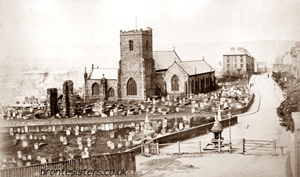
Charlotte and Anne Bronte travelled with Ellen Nussey to Scarborough
via York. Anne died whilst at Scarborough 28 May 1849 and was buried there,
at St Mary's Church, Castle Hill.
In October 1849, Charlotte's novel 'Shirley' was
published and is thought to be the first writer to use the word 'daguerreotype' as a
verb in a novel..... "struck on her vision with painful brightness . . . as vividly as if
daguerreotyped." and "Caroline saw a shape, a head that, daguerreotyped in that attitude
and with that expression, would have been lovely."
|
|
1850
|
|
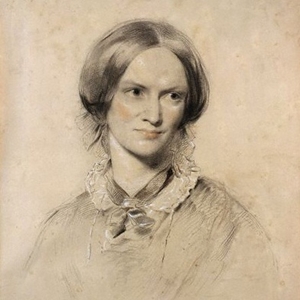
Charlotte's portrait by George Richmond and an
engraving of the Duke of Wellington created from Claudet's daguerreotype of
1844.
|

|
Charlotte visited London and in June 1850 sat for her portrait
by George Richmond. The portrait arrived at Haworth Parsonage in July 1850 along
with another gift, an engraving of the Duke of Wellington created from Claudet's daguerreotype of
1844. The following October Charlotte stayed in Windermere and met Elizabeth
Gaskell, her future biographer.
|
|
1851
|
|
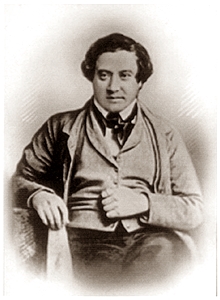
The sculptor, Joseph Bentley Leyland, (who had been one of Branwell
Bronte’s closest friends) died 28 January 1851. A daguerreotype of him
survives. Like Branwell, Leyland enjoyed 'socialising' and was at times heavily in
debt.
Charlotte visited the Great Exhibition at the Crystal Palace, London.
|
|
1852-3
|
|
Collodion Photographs
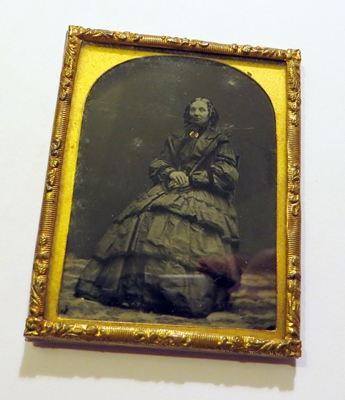
Daguerreotypes were images on a silvered copper plate but in the early
1850s a new type of photograph appeared. Collodions were photographs on glass and the
great advantage was that they were easier and cheaper to produce. They almost completely replaced
the daguerreotype by the end of the 1850s.
Watch a five-minute video explaining the
collodion process - by George Eastman
Museum.
Although collodion replaced the older process most members of the public still
referred to them as daguerreotypes and the term "to daguerreotype" meaning "to
photograph" was used for many years after. In the UK today these 'collodions' are often called
'ambrotypes' but the latter is really an American term.
Like daguerreotypes, almost all collodions were reversed images so any visible
text, in a shop sign for example, would be back to front.
Below: An advert for Marchbank, photographer, Bradford, 1853 with the cheerful
slogan: "Remember, a good likeness is all that can be rescued from the
grave."The price of a basic daguerreotype throughout the 1840s was about a guinea
(£1.05p) but collodions were far more affordable. Marchbank was charging 6s 6d (32½p) for a
collodion portrait.
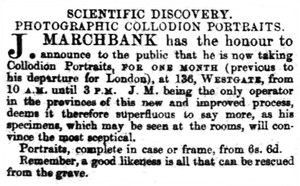
|
|
1854-6
|
|
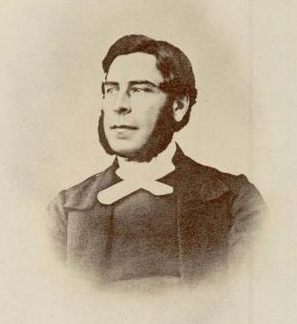
Arthur Bell Nicholls married Charlotte Bronte 29 June
1854 but the marriage lasted just nine months as Charlotte died
31 March 1855. Photos of Arthur Bell Nicholls exist but the earliest of these
are thought to be carte de visites dating to the 1860s.
Elizabeth Gaskell began compiling her biography of Charlotte in
1856. John Stewart, a friend of Charlotte's publisher, visited Haworth to
photograph the 'Richmond Portrait' of Charlotte to illustrate the biography. Photos were
rarely reproduced in books until the 1880s so an engraving of the photo was created by J
C Armytage.
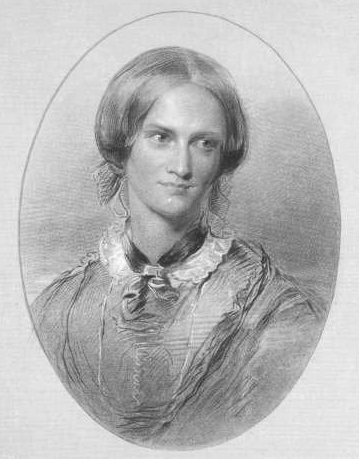
|
|
1857
|
|
In February 1857, before John Stewart returned to France, he
made a third visit to Haworth Parsonage. Whilst there took photos of Haworth Village & the
Parsonage and the photo above, taken from the Church tower, may have been one
of these.2b. The unusual hand cut metal
mat is similar to the one in the 'Bronte Sisters Photo' which was found
in France. Elizabeth Gaskell's Life of Charlotte Bronte was published in March
1857 and Charlotte's novel The Professor was posthumously published
in June.
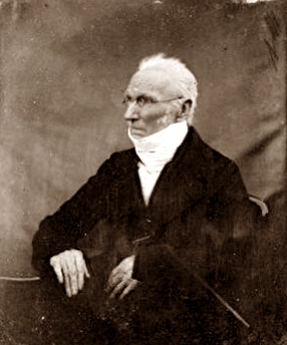
In the late 1850s several collodion photos were taken of Rev Patrick Bronte
(1777-1861) by a local photographer.2c About this time the
two group portrait paintings of the Bronte sisters were photographed for the Bronte's servant,
Martha Brown, again by a local photographer.
|
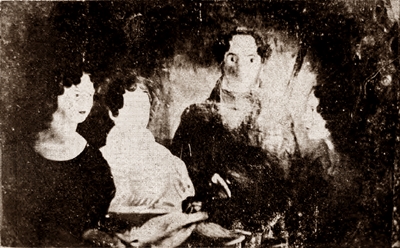
The 1830s 'Gun-Group' portrait, photographed for Martha Brown c1858.
|
|
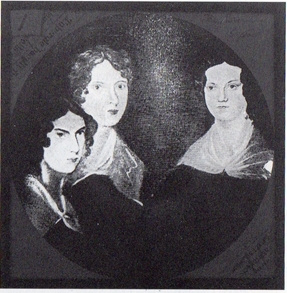
The 1830s 'Pillar' portrait, photographed
for Martha Brown c1858.
|
|
|
1860s
|
|
The first carte de visite photos were produced in England in
1860. These were small photos on a card mount and were popular until the 1880s,
when larger 'cabinet photos' were the norm. The advantage over collodions were that they
were cheap, unbreakable and could be sent through the post. They were
often stored in a personalised book, a photograph album.
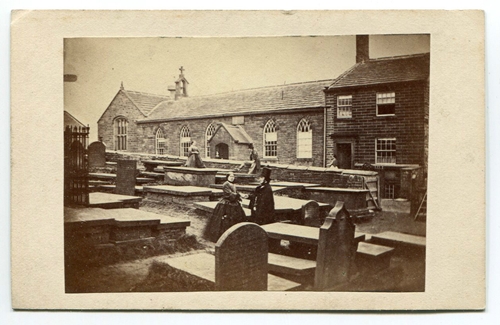
Daguerreotypes were superseded by the glass collodion photos of
the 1850s and these in turn were largely replaced by carte de visites in the 1860s and cabinet
photos in the 1880s, though not completely.
|
|
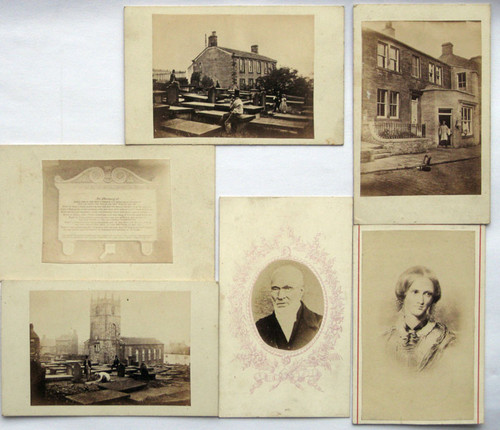
Most carte de visites were portraits taken in studios but others were
mass-produced, featuring royalty, politicians, clergy , actors and other famous people. Some were
topographical - scenic views, of the seaside, castles, churches & buildings. They became very
collectable and were often exchanged.
Several different views exist of Haworth Parsonage & Church, Patrick Bronte
and Charlotte and places associated with the family.
The Rev Patrick Bronte died in 1861 having outlived his wife
and five daughters. Arthur Bell Nicholls (Charlotte’s widower) left Haworth for Ireland taking with
him many portraits and documents.
|
|
1. "Thompson, John, artist and beerseller,
Manchester Road." Ibbetson's Directory of the Borough of
Bradford, 1845. p.82 For biographical information see:
John Hunter Thompson.
1a. There was an advert in a newspaper:
“Photographic portrait establishment of the Royal Polytechnic Institution of London, and at the
Bazar Pantechnique, near the Park in Brussels. The photographic process for making
portraits is an improvement of Monsieur Daguerre’s method. Mr Richard Beard has just obtained a
patent for Belgium. Portraits taken by this method require several seconds of exposure only and
possess a softness and a delicacy which can only be obtained by the process of Monsieur
Daguerre.” (Journal de
Bruxelles, 11 March 1842).
The Bazar Pantechnique was a shopping centre
or arcade which existed in the early 1840s; the building had previously been the Royal
Stables. It also housed a shop selling hunting and riding equipment and the workshop of the
sculptor, Pierre-Joseph Feyens, who in 1841 had created a marble bust of Leopold I of
Belgium. For a map giving the approximate location of the Pensionnat Heger in rue
d’Isabelle (streets long since demolished) and the Bazar Pantechnique (Royal
Stables) CLICK HERE.
For images of the building (Royal Stables): Écuries royales de Bruxelles CLICK HERE.
1a. See also an advert for the
Leeds Photographic Portrait Gallery,
1842.
2. This is probably the earliest photo in the
Bronte Parsonage Museum. Permission would have been needed to carry the bulky
camera, collodion equipment and chemicals through the church and up to the tower. The
glass plate had to be coated with a chemical mixture, placed in the camera whilst still wet, the
picture taken, glass plate removed and then developed, all within about ten minutes. The plate
then had to dry before being placed in a frame.
2a. The bust was probably donated to the
Master Mariners' Asylum. The busts of "the Duke of Northumberland, George Straker and the late
Robert Spence, executed by [Christopher] Tate [1811-41] and [James] Shotton [1824-96]" were
displayed at the anniversary meeting of the Master Mariners' Association held at the George Inn,
Tynemouth, January, 1847 (see Newcastle Journal - Saturday 30 January 1847).
2b. This photo would have originally been viewed as
a reversed image with the collodion (image) side facing the front and protected by the glass in
front. At some later date it has been turned round.
2c. For information about neckcloths see:
Jane Austen's World - The Art of Tying the Cravat, The Regency Neckcloth & Neckclothitania.
3.
"On Sunday morning last, at the Parsonage, Haworth, Mr.
Branwell Bronte, son of the Rev. P. Bronte, incumbent of Haworth. This announcement will, no
doubt, be read with sincere regret, by those in different parts of the country who have had
the pleasure of his acquaintance, he having been extensively known from the situation he
formerly held on the Leeds and Manchester Railway, and since then, as tutor in a gentleman's
family, near York; he has however, lately lived with his father and sisters at the Parsonage,
Haworth.
The talents and
accomplishments of this young gentleman have very rarely been excelled. Gifted with great natural
quickness, an acute perception, and a solid judgement, he was, so far as his mental endowments were
concerned, admired by all who knew him, while his bland and urbane manners and remarkable
conversational powers, charmed and captivated all by whom he was surrounded.
His premature
death - in his 31st year - has thrown his aged and respected father, and his three sisters, into
the deepest sorrow, and his friends are ready to acknowledge that the brightest ornament of the
social circle has gone. His mortal remains were conveyed to their final resting place, in Haworth
Church, on Thursday last, amidst a crowd of sympathising spectators." Leeds Times, 30
Sept 1848.
|
|
|

